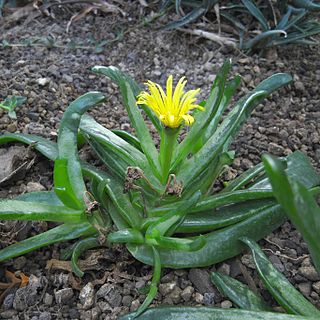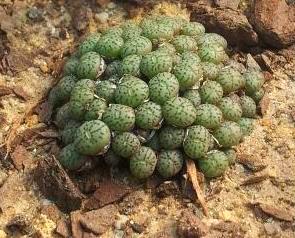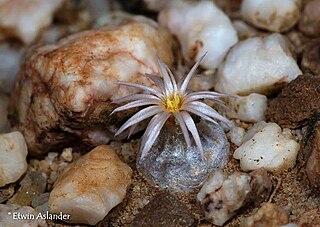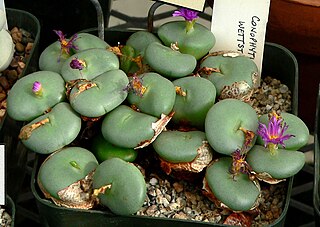
The Aizoaceae, or fig-marigold family, is a large family of dicotyledonous flowering plants containing 135 genera and about 1800 species. They are commonly known as ice plants or carpet weeds. They are often called vygies in South Africa and New Zealand. Highly succulent species that resemble stones are sometimes called mesembs.

Lithops is a genus of succulent plants in the ice plant family, Aizoaceae. Members of the genus are native to southern Africa. The name is derived from the Ancient Greek words λίθος 'stone' and ὄψ 'face', referring to the stone-like appearance of the plants. They avoid being eaten by blending in with surrounding rocks and are often known as pebble plants or living stones. Lithops is both the genus name and the common name. The formation of the name from the Ancient Greek -ops means that even a single plant is called a Lithops.

Pleiospilos is a genus of succulent flowering plants of the family Aizoaceae. It is endemic to the Cape Provinces of South Africa. The name is derived from the Greek pleios "many" and spìlos "spot". The plants are also known as kwaggavy, lewerplant, lewervygie, klipplant, split rock or mimicry plant.

Conophytum is a genus of South African and Namibian succulent plants that belong to the family Aizoaceae. The name is derived from the Latin conus (cone) and Greek phytum (plant). The plants are also known as knopies, waterblasies, sphaeroids, conos, cone plants, dumplings, or button plants.

Glottiphyllum is a genus of about 57 species of succulent subtropical plants of the family Aizoaceae. It is closely related to the Gibbaeum and Faucaria genera. The name comes from ancient Greek γλωττίς glottis "tongue" and φύλλον phyllon "leaf". The species are native to South Africa, specifically to Cape Province and the Karoo desert. They grow in rocks and soils incorporating slate, sandstone and quartz. Rainfall in their native areas is between 125 and 500 mm, most of which falls in March and November.

Conophytum jucundum is a species of succulent plants belonging to the family Aizoaceae. As its synonym Conophytum gratum, the pleasing cone plant, it has gained the Royal Horticultural Society's Award of Garden Merit.
Gert Cornelius Nel was a South African botanist. His formal botanical author abbreviation is Nel.

Conophytum calculus is a small South African species of succulent plant in the family Aizoaceae.

Conophytum breve is a small South African species of succulent plant of the genus Conophytum.

Conophytum flavum, the yellow cone plant, is a small South African species of succulent flowering plant of the family Aizoaceae.

Conophytum ficiforme is a small South African species of succulent plant of the genus Conophytum.

Conophytum truncatum is a small South African species of succulent plant of the genus Conophytum.

Conophytum piluliforme is a small South African species of succulent plant of the genus Conophytum.

Conophytum minimum is a small South African species of succulent plant of the genus Conophytum.

Conophytum hammeri is a small, endangered, South African species of succulent plant, of the genus Conophytum.

Conophytum pellucidum, called the transparent cone plant, is a species of flowering plant in the genus Conophytum, native to the western Cape Provinces of South Africa. It has gained the Royal Horticultural Society's Award of Garden Merit.

Conophytum wettsteinii is a species of flowering plant in the genus Conophytum, native to the northwest Cape Provinces of South Africa. It is known to grow in rocky regions, often nearby Crassula elegans. C. wettsteinii is a small groundcover species, which appears stemless with fused leaf-pairs having a obconical shape. This plant relies on winter rains and is mainly dormant in summer months. Best growth occurs when drainage is available, and when only shaded during mid-summer. Propegation can occur through seeds or through cuttings from a full grown plant, where each cutting contains at least 1 head and a fraction of root. It has gained the Royal Horticultural Society's Award of Garden Merit.
Stayneria is a genus of flowering plants belonging to the family Aizoaceae. It contains a single species, Stayneria neilii. It is in the subfamily Ruschioideae and the tribe Ruschieae.
Conophytum chrisolum is a species of succulent plant in the family Aizoaceae. It is endemic to the Richtersveld region of Northern Cape Province in South Africa. It may be the smallest free-living, land dwelling (non-aquatic) flowering plant, and certainly is the smallest succulent, measuring no more than 0.4 inch (10 mm) in height by less than 0.25 inch (6 mm) in width. It never branches or divides. It was only discovered in 1994 by botanical explorer Chris Rodgerson. The solitary magenta colored flower, up to 0.8 inch (20 mm) in diameter, is wider than the plant.
















